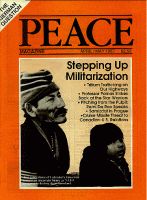
Peace Magazine Apr-May 1987, page 45. Some rights reserved.
Search for other articles by Beverly Olds here
The Public Education for Peace Society (EPS) has completed a successful peace education pilot program in the Burnaby, B.C. public school system, and is currently working on another. The first program was a general peace education program for grade six and seven students, and the second focusses on conflict resolution skills for students in grades four and five.
There were three phases to the first peace education project implemented by the PEPS. First came a needs assessment, second, the actual implementation and, third, post-implementation evaluation and production of a video documenting the project.
The needs assessment was done by Susan Hargraves. Over 700 Burnaby students took part in the "Nuclear Information Study," which clearly showed that young people are aware of nuclear issues. Most of them become aware in elementary school, and the most common source of awareness is usually television. Young people were not only aware, they were also frightened, and interested in learning more. These results convinced the school board to pilot the program for grades six and seven. At this age, students are especially anxious about the nuclear threat and especially eager for more information. In cooperation with the Faculty of Education at Simon Fraser University, Burnaby professional development staff and a group of grade six and seven teachers, the curriculum "Conflict and Change" was developed. Care was taken not to increase the anxiety level of the students. Parents were consulted and were given the option of withdrawing their children from the program.
The curriculum was based on a study of conflict at the personal and the global level. At both these levels students studied ways to resolve conflict without hurting others. This challenges the all too commonly held notion that conflict must lead toviolence.
More specifically, the lessons began by encouraging students to discuss personal conflict situations. The next two lessons examined "points of view" and anger in conflict situations, and began to offer solutions to conflict.
The classic win/win, lose/lose grid was introduced here. The terms for these concepts were found to be an extremely effective teaching tool, and were observed being used by the students beyond the classroom.
The fourth lesson moved from personal to international conflict by introducing world hunger as it relates to the distribution of resources. The next lessons expanded on conflict between countries, examining "Images of the Enemy" in the context of student's views of the USSR. They were shown the film "What Soviet Children are Saying About Nuclear War." The students were powerfully affected by the comparison between themselves and Soviet youth.
Next, students were encouraged to express their own feelings on nuclear war in a supportive environment. Many students reported that they had never had a chance to talk about this issue before.
The eighth lesson provided information on nuclear weapons and war, and finishing with sessions designed to empower the students. One session gave Martin Luther King as an example of what one person can do. In the final lesson, children chose personal concrete actions for peace.
Teachers evaluated each lesson, as well as the curriculum as a whole. Project staff attended 75 percent of the lessons and each class was videotaped for three key lessons. Students also gave evaluations, and were tested for changes in their knowledge of nuclear issues and level of anxiety. The reactions from parents and teachers have all been positive. From these evaluations, the curriculum has been revised and expanded to fourteen forty-minute lessons, and a videotape entitled "Learning Peace" has been produced documenting how the curriculum was used.
The PEPS is now developing a curriculum based on the extremely effective "personal conflict resolution" section of the previous program. It is now being implemented in the Burnaby School District in grades five and six.
The staff designed a twenty-eight lesson curriculum, and began working with 160 students in September. By developing self-awareness of feelings, and their effect on how people act, the program aims to increase children's sense of control over their own conflicts, and to give them hope about conflict resolution at an international level.
Interim reports indicate that the response to this program has been very good. Plans are in motion to develop a curriculum package and a workshop based on the project for teachers interested in these skills. More information on these projects can be obtained from: PEPS, Box 2320, New Westminster, B.C., V3L 5A5. General information on peace education will soon be available through the newly-formed Canadian Peace Educators Network.

Peace Magazine Apr-May 1987, page 45. Some rights reserved.
Search for other articles by Beverly Olds here